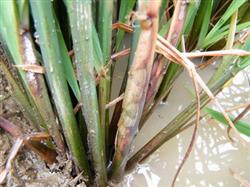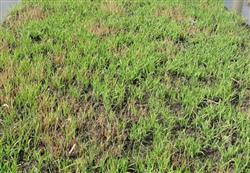What is rice sheath blight?

What is rice sheath blight? What are the hazards of rice sheath blight? Please help introduce friends. The harm of rice sheath blight: rice sheath blight is also called cloud disease. The disease can occur from seedling stage to ear stage. The infected leaf sheath produced dark green water-soaked fuzzy small spots near the water surface, then gradually expanded into oval or moire shape, the middle part was grayish green or grayish brown, the middle part was pale yellow or grayish white when humidity was low, the middle tissue damage was translucent, and the edge was dark brown. When the disease is serious, several spots fuse to form large spots, showing irregular moire spots, often causing yellow leaves to die. Leaf infected spots were also cloud-shaped, yellow edge, rapid onset of the disease spots were dirty green, leaves quickly rotted, stem symptoms like leaves, late yellow brown, easy to fold. The ear neck is polluted green at the beginning, then becomes gray brown, often can not head, heading grain more, 1000-grain weight decreased. When the humidity is high, white reticular hyphae grow out of the diseased plant, and then converge into white hyphae mass, forming sclerotia, which is dark brown and easy to fall off. Under high temperature conditions, a white powdery layer was produced on the diseased spot, that is, basidia and basidiospores of the pathogen. Causes of rice sheath blight: Sclerotinia sclerotiorum of early rice was the main infection source of sheath blight of late rice. The number of sclerotia was the main cause of the disease. There are more than 60 000 sclerotias per 667m2. Under suitable conditions, sheath blight can be caused. High temperature and humidity is another main factor of rice sheath blight. It can occur at temperatures of 18-34℃, with the optimum temperature of 22-28℃. The relative humidity of the disease is 70%-96%, and more than 90% is optimal. Mycelia can grow at 10-38℃, sclerotia can form at 12-40℃, and the optimum temperature for sclerotia formation is 28-32℃. Sclerotinia germinates and forms hyphae when relative humidity is above 95%. 6-10 New sclerotia can be formed in the queen of heaven. Sunlight can inhibit mycelium growth and promote sclerotia formation. Rice sheath blight is suitable for occurrence and epidemic under high temperature and humidity conditions. In the early stage of growth, there were many rainy days, high humidity, low temperature, slow expansion of disease, high humidity and high temperature in the middle and late stages, and high temperature and dryness inhibited the disease. When the temperature is 20℃ and the relative humidity is more than 90%, sheath blight begins to occur. When the temperature is 28-32℃, the disease develops rapidly in case of continuous rainfall. When the temperature drops below 20℃ and the relative humidity in the field is less than 85%, the disease is delayed or stopped. Long-term deep irrigation, partial and late application of nitrogen fertilizer, rice canopy, excessive growth promote the occurrence and spread of sheath blight. Click for more rice cultivation technology Click for more food crop cultivation technology
- Prev

How to control rice sheath blight?
What is the harm of rice sheath blight? How to control rice sheath blight? Netizens are also asked to help introduce the harm of rice sheath blight into leaf sheath disease, leaf disease and stem disease, which are described in detail as follows. Leaf sheath disease: dark green water-immersed edge blurred spots appear near the water surface, and then gradually expand into an oval or.
- Next

How to control rice blight by seedling?
How to control rice blight by seedling? Are there any effective prevention and control methods? Rice bacterial wilt is the number one disease of rice seedlings. Generally, rice bacterial wilt can be divided into two types: one is fungal bacterial wilt, the other is physiological bacterial wilt, also known as bacterial wilt. The following is aimed at the blight.
Related
- The first cup of black tea in spring, the flavor and history of tea gardens in Kenya, Africa
- The computer can not only choose potatoes, but also grow tea rice. AI will grow winter oolong tea champion.
- It is not only the inflated tea bitten by insects, but also engraved with the four seasons tea in Beipu.
- The Oriental Beauty Tea Festival in Zhuxian County takes the stage at the weekend to experience the plus-size feast of oil tea.
- & quot; Oriental Beauty Tea & Exploration of Emei in Hsinchu, the hometown of quot;
- The new variety of strawberry "Tainong 1" dessert is the first choice with mellow aroma. Crimson gorgeous
- History of Tea in Taiwan: from Wild Inner Mountain to Export Tea Garden
- Two types of Taiwan Oriental Beauty Black Tea won the British three-Star Award for Childhood Tea Xiang Zhang Jiaqi changed from pilot to champion tea maker.
- Banana species and varieties: the planting history of Taiwan Xianren banana and dwarf banana is long, is banana disease resistant?
- Coffee planting Technology: Qianjie Coffee from Seedling to harvesting

